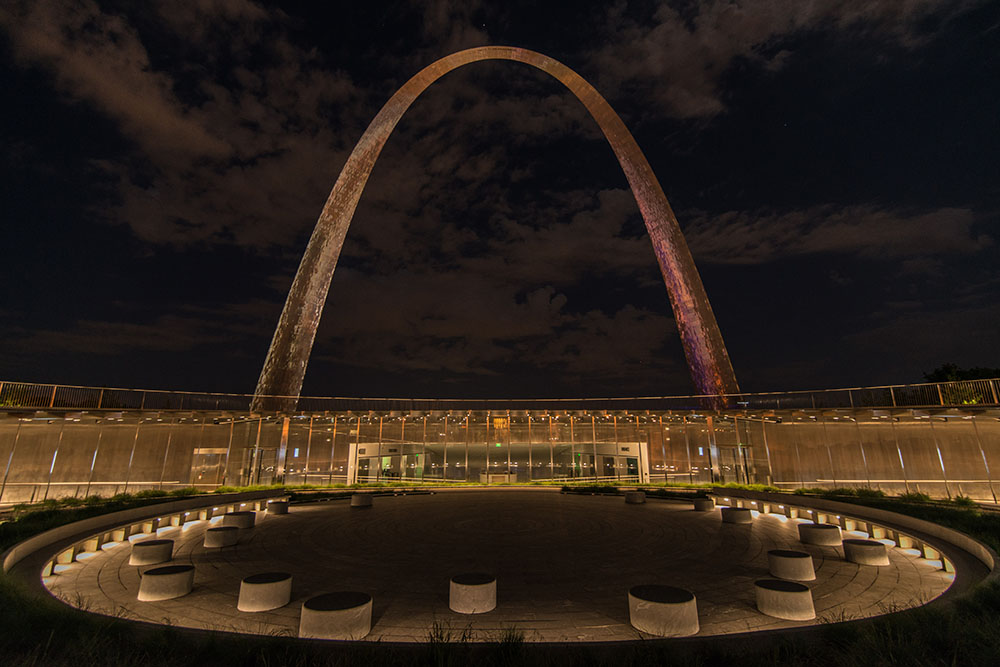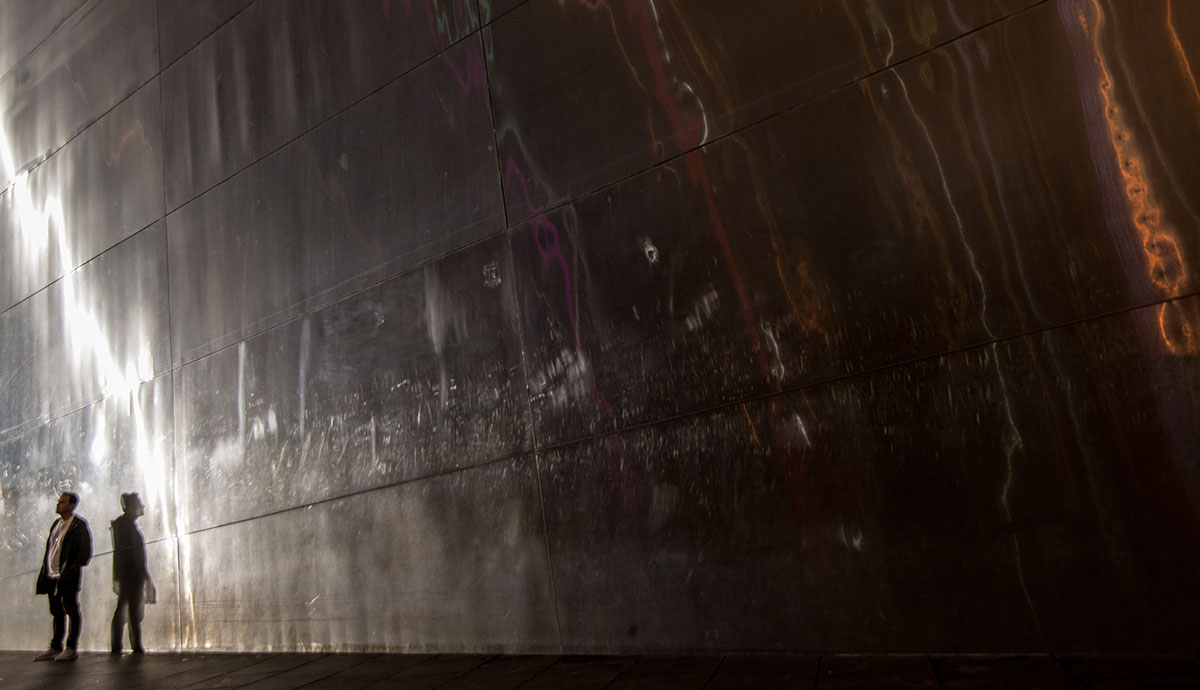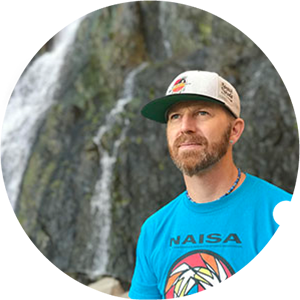When the email arrives, I’m sure there’s been a mistake. The National Park Foundation, through a third-party marketing agency, has invited me on a media trip to write an article that would generate tourism for some of the country’s lesser-known national park units. The problem and irony with this email is that the Foundation—the official nonprofit partner of the National Park Service—has selected the only park that has me scratching my head, the single unit that could redirect the NPS’s storied legacy predicated upon monumentalism, recreation, and preservation. It’s perhaps our most unique national park and where the fate of the National Park Service is playing out. Yet, nobody knows about it.
The park in question is a 630-foot arch. In terms of geology, this measurement would be record setting, more than doubling the world’s next closest arch in both height and span, if the thing was natural, but it’s not. This arch is human built, constructed between 1963 and 1965, and, according to its funding advocates, to be “a memorial to the men who made possible the western territorial expansion of the United States.” Stainless steel covers the structure and glistens to city lights, with corporate logos like “Shipworks” and “Hyatt” owning the immediate skyline. Interstate 44 runs beneath the 91-acre park property, offering the bustle and air pollution of a 2.9-million-person population skittering hither and yon. No night sky. No silence. Just a city predicated upon industrial progress and its consequences—
What we have is downtown St. Louis, Missouri, and its freshly designated “Gateway Arch National Park.”
To understand the significance of this outcome first requires a minor understanding of the National Park Services’ tangled history of development, establishment, and expansion. During the last 150 years, via political jostling over public lands management, the NPS has come to administrate 421 park units. These units can range from designations like national lakeshores to national monuments to national historic trails. By my estimation there are over 40 different designations, though many are so close in nomenclature it’s hard to justify distinction: like a national historic site vs. a national historic park vs. a national historical park, or a national battlefield vs. a national battlefield park vs. a national battlefield site. Of this list, the apex has long been the full-fledged “national park.” These would be your Yellowstones, Yosemites, and Grand Canyons. Of the 421 units, 62 are national parks. Gateway Arch, formally designated as a national memorial, is now included in this elite group.
The designation upgrade came on February 22, 2018, when President Trump signed into law S. 1438, the “Gateway Arch National Park Designation Act,” setting in motion the rebranding of Jefferson National Expansion Memorial. Trump’s signature came on the heels of congressional approval, which faced little opposition and moved through the House and Senate within eight months (for context, it took over a decade for Grand Teton to get approval). Senator Roy Blunt, one of the Gateway legislation’s Republican sponsors, explained that, “renaming the park will better highlight its central feature and make it more immediately recognizable to the millions of people who visit St. Louis every year.” Further research gives similar reasonings: it was a bi-partisan move, in a bi-partisan state, during a time of little compromise and cooperation in Congress, that united both parties under a mutual interest. Rebranding the “memorial” as a “national park” was sure to re-stimulate Missouri’s stagnant economy and draw tourists in through the trusted outdoor trademark. And it worked.
The lasting cost of the alteration, however, beyond Gateway’s $380 million remodeling job (the majority privately funded), falls on the park system as a whole, challenging its values and own identifying rhetoric, like: “Generally, a national park contains a variety of resources and encompasses large land and water areas to help provide adequate protection of the resources.” What’s puzzling then is that there is little inherently natural or expansive about Gateway. The property in total equals 69 football fields, something you could walk in an afternoon. By comparison, Death Valley National Park equals 2,575,758 football fields. The only arguable resource at Gateway is educational and, hence, requires no more protection beyond that of an underground museum and historic courthouse. Other parks protect the tallest, biggest, and oldest trees on the planet; the world’s longest cave system, the country’s clearest and deepest water; the tallest peak in North America; the darkest night skies; the few places that still have true silence; temperate rainforests; ancient bedrock; petrified barrier reefs; the majority of the world’s geothermal features; and all the biodiversity that spans from the Arctic Circle to the Everglades. Yet, Gateway’s trees are planted and ponds artificial. Their website, unlike most other park sites, doesn’t have a nature section in homage to flora and fauna—because at best you might see an opossum. Gateway doesn’t even have naturally growing grass, the gridlines of laid sod guiding your eyes in linear patterns across the landscape. In fact, a ranger told me, after their grand opening on July 3, 2018, the lawn was so spoiled by participants they had to put new sod down—which then spoils, in many ways, the very act establishing the National Park Service as an agency with its famous phrase to leave parks “unimpaired for the enjoyment of future generations.”
But . . . who really cares? At a time when gun violence is rising, basic human rights are being challenged, and one million species are under threat of extinction in the next few decades, what is the final weight of a squabble over “national memorial” vs. “national park”? The worst that may come of this for most people is having to look at pictures of a steel arch, sandwiched between images of caribou herds and glacial peaks, in upcoming guidebooks. Not emergency status, right? The answer is ambiguous and multifaceted. That’s why I needed to accept the Foundation’s invitation and go see for myself.
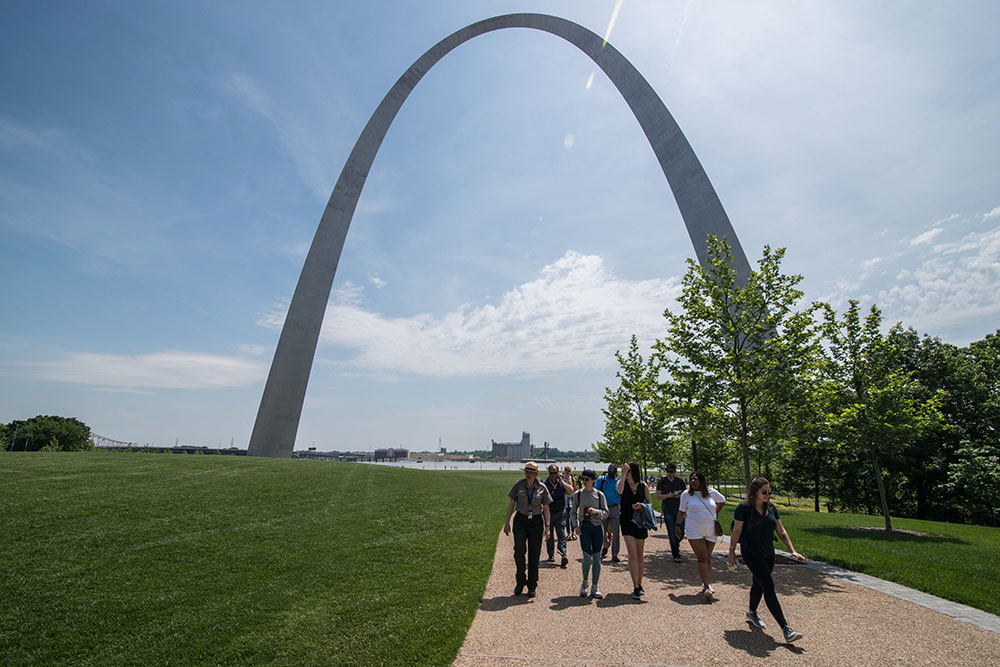
Approaching Lambert International Airport, I crane my neck across a stranger in the window seat. She doesn’t notice because she’s finishing her in-flight entertainment—a documentary about the daredevil who big wall climbs in Yosemite without a rope, the film including expansive shots of ancient granite, old-growth forest, whitetail deer in morning meadows. Out the window is a different scene of patchwork development from above, roads and rivers and farmland and subdivided habitat. I’m trying, in vain, to catch a glimpse of what brought me here.
After deboarding the plane, my short walk to the shuttle is fine, though, at the stop, a stranger deems it appropriate to blow snot rockets while waiting. With his phlegm coating the concrete, I question my open-toed-shoe decision and sidestep his trajectory. Thank God it’s not raining. Someone else, a character in my periphery, is trying to earn me as an ally in his complaints against the shuttle delay. I let headphones act as a barrier to privacy and keep my gaze low, though this is where the mucous lives. I pretend to look at Instagram.
Once at the rental lot, I meet my friend Alex, a photographer and Native American Studies graduate student I’ve invited to join me on the journey. He’s travelled from our hometown in Montana, a place just 20 miles from the headwaters of the Missouri river. Of the three rivers that converge there, two consummate in Yellowstone. These watersheds form a life blood that gives vitality to the Midwest, traversing seven states before reaching St. Louis and fusing into the mighty Mississippi. He and I have smoked many late-night cigarettes on the Missouri’s riverbanks; to be here, together, at the river’s terminal point feels somehow sacred.
The sentiment is short lived: from Hertz, the interstate traffic is terrible. I’m told a shooting is to blame, three dead. And I know I wasn’t made for this, not for population centers this size, but we head toward the Hyatt nonetheless, to the heart of downtown, and as we take the bend somewhere near College Hill the magic finally happens. Alex says as much—"There she is”—and just like Rainier over Seattle or Fuji over Tokyo, the 630-foot glistening stainless steel structure brings magnitude to the horizon, emerging between brick industrial buildings and dull concrete overpasses. Awe triggers between my synapsis. I gawk. The St. Louis Arch.
It’s gorgeous. And though I once lived in this state fifteen years ago, I’d forgotten how stunning our country’s tallest monument is, a point of architectural esteem on par with the Eiffel Tower. I feel American pride. But unlike Rainier or Fuji, the sight is not inner-city juxtaposed with outer-wild; it is not the promise that somewhere beyond these gridlocked roads is refuge from the racket of autos and light pollution and phlegm-covered sidewalks. No, this represents something different. Something foreign to me. This is, perhaps, a national park for the next generation—a national park for those reared in cities, those reared on the Internet, those facing barriers of transportation and the rising costs of recreation. My first and lasting reaction is to scoff at the absurdity—this thing? a national park?—but I then wonder if my response is steeped in privilege. This might be the best solution to a rising necessity of green space in a growing world of concrete.
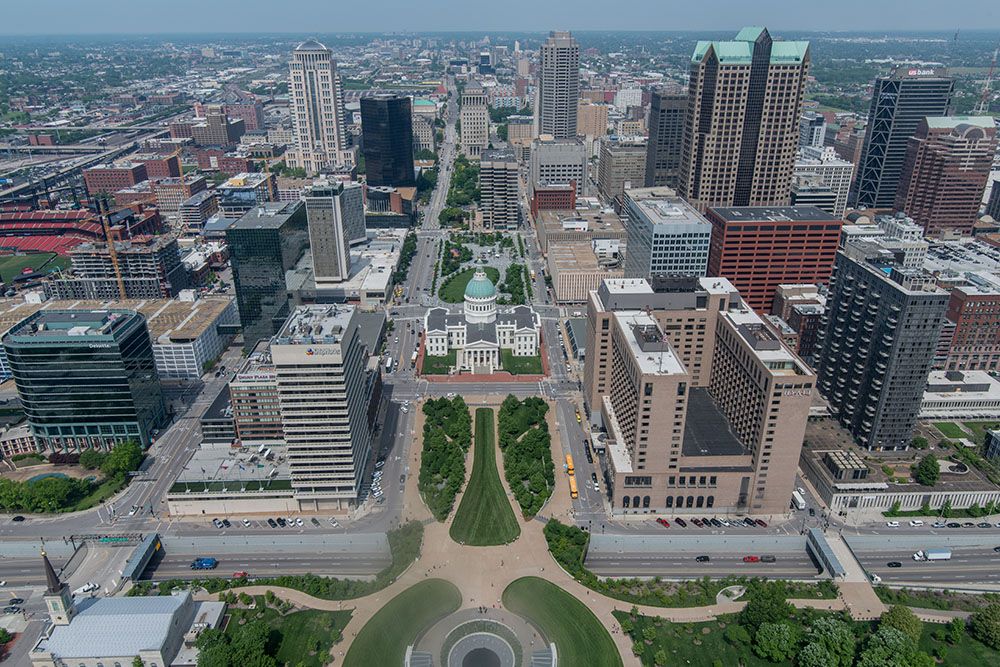
Alex and I approach our destination, a corporate hotel directly across the street from Gateway. I’m still enthralled with the magnitude of the Arch, the structure drawing my eyes skyward every time a new view opens, a distraction more dangerous than texting and driving.
This city, by American standards, is old, founded in 1764 by French fur traders. Prior to that, Native American mound builders settled the riparian zone, commemorated by the nearby Cahokia Mounds State Historic Site, and later became ancestral lands to the Osage, Miami, Sioux, and Haudenosauneega Tribes. St. Louis officially joined the United States through the Louisiana Purchase in 1803, operating as a major trading post along the Mississippi. That is, humans have long made use of the river. This becomes important to me because, in 1804, Lewis and Clark embarked from these very riverbanks to set the ethos of Manifest Destiny into motion, following a 2,341-mile Missouri river that led all the way to the future site of my hometown in Montana. And now, 215 years later, I gape beneath a contemporary marvel commemorating the United States president who made it all possible, Thomas Jefferson and his formally christened National Expansion Memorial.
Times have changed but the hubbub hasn’t: horns blare to slight traffic errors; sirens, somewhere in the distance, ricochet through municipal canyons; parking is a nightmare. Our room is exceptional though, standard in most conventional ways, but with a view: from 14 floors up, we have a panoramic overlook of the park. To the left, east, is half the Arch. Below is the visitor center entrance, a circular plaza with a shallow infinity pool that leads patrons to the underground museum. To the right, west, is the Old Courthouse, which is also included in the park property and site of the famous Dred and Harriet Scott case. This famous building is where the Black enslaved couple, plus their two daughters, sued for their freedom, litigating for a decade and making it all the way to the Supreme Court. Dred and Harriet ultimately lost their fight for freedom, but the case provided momentum to the anti-slavery movement and gave headway to the Civil War. The Courthouse’s nineteenth-century architecture stands out amongst modernity, the cast-iron dome making many believe it a state capitol building (though this honor belongs to Jefferson City). Kids cruise about on scooters. People walk Luther Ely Smith Square’s curvaceous sidewalks, the park designed to mitigate any hard lines and corners (besides the sod, of course). Directly beneath the Arch a group is playing soccer. Beneath them, the buried museum. The Mississippi flows beyond the Arch, riverboats along the closest bank, Interstate 55 crossing to Illinois further south. Hallowed plains ubiquitous.
A storm has rolled in, the type west coast living doesn’t offer, and in between lighting strikes and its subsequent booms, from the curated trees on the periphery, I hear birdsong. The moon hangs as a sliver. Surprising peace.
Alex, being Alex, is ready to go, camera in hand. There will be no rest amidst his curiosities. From the elevator, we pass the hotel’s sports bar, their hain-house Starbucks, the valet station, cross Chestnut Street, and then . . . we’re in a national park. The only other place this is remotely possible is Hot Spring National Park, also in an urban setting and formerly the smallest national park, at 5,500 acres (61 times the size of Gateway).
We walk to the grassy knoll at the center of the park, almost drawn there, situated between the Arch and the Old Courthouse. From here the Arch is fully visible, a mercurial brand in the sky, the upward bend replicating the droop of a hanging chain. This must be the most iconic spot to take a picture in the park—perhaps the whole city—just like the Tunnel View in Yosemite, or Delicate Arch in Utah. An older gentleman next to me, framing the scene with his smartphone, chuckles with pleasure to the quality of his shots despite the lighting.
“Pretty incredible, isn’t it?” I say.
“Never thought I’d get to see it in my life,” he responds with the reverence of standing before Egypt’s great pyramids, not taking his eyes off the structure. Any other small talk would ruin the romance, so I just admire him admiring the Arch at the twilight’s last gleaming.
With the sun now set, streetlights trigger and enhance the scene. Bugs swarm. Trees become silhouettes. The stainless steel bends and amplifies the glow. Clouds gather. Alex is swapping lenses to accommodate new needs, setting up tripods, splaying out on his belly, having me pose for stilled shots, having me aim my phone’s flashlight to enhance a scene. And by the time we reach 4th Street, near the Old Courthouse, he’s so wrapped in his art that he’s leaving gear strewn about, amidst the sidewalk, and I experience an anxiety I’ve never felt in a national park before: I’m concerned his stuff’s going to get stolen.
Groups of drunks walk by, enjoying the downtown scene. Teens pass through our shots with the intention of disruption. Anyone could grab a lens and run, disappearing to the side streets of a city we’re not familiar (St. Louis, after all, has one of the country’s highest crime rates). The encompassing streets then become odd demarcations of park and city, creating clear distinctions between people groups: not everyone is here for the NPS experience—most aren’t. They pass by with no regard. It’s just a city, like any city, and we’re tourists. There’s no unspoken agreement of the wild.
Alex and I stay at it until 1am. Nothing gets lifted. The place empties. A storm has rolled in, the type west coast living doesn’t offer, and in between lighting strikes and its subsequent booms, from the curated trees on the periphery, I hear birdsong. The moon hangs as a sliver. Surprising peace. Yet, similar to all city parks after dark, it feels as if we’re violating an ordinance and shouldn’t be here, but no one comes to prove the assumption, making me contemplate what lurks in shadows beyond the birds.
Alex shows no concern, snapping away. His only fear that his 1,000-image memory card won’t suffice; fearful his cheap travel tripod, recently purchased as a last-minute fix, won’t still the camera’s waiver. I don’t mention the paradox of being in a national park after midnight, while also being in the heart of a city, removed from camping and adequate hiking trails. But I do pay service to my growing paranoia:
“What if it’s all a ruse?” I say. “Like a smokescreen.”
“What do you mean?”
“It’s just interesting, you know, that the current administration has been so adamant about opening public lands to resource extraction, like in Bears Ears and Grand Staircase-Escalante . . . yet they’re upgrading the protection in a place like this.”
“It is suspicious,” Alex says, “especially when you consider that this place, in a way, is celebrating the expansion that further eradicated Indigenous tribes, while Bears Ears, on the other hand, was protected at the behest of five local tribes trying to preserve their sacred lands and cultures. This feels like more salt in their wounds.”
“Exactly. It kind of feels like this place is a distraction to further gut the American West, doesn’t it?”
“Makes you wonder what precedent this is going to set . . . if they’ll make something like the Sears Tower in Chicago a national park next, or the Empire State Building in New York.” We both laugh at the absurdity, though it’s not funny.
Lightning strikes in the distance right on cue, bringing punctuation to my darker thoughts, such as: By plopping national parks down in the center of cities, for innocuous purposes like rebranding and increased tourism, are we doing more damage than good? The Democrats are happy. The Republicans are happy. City planners and park patrons too. Not only that, but increased numbers of youth are now getting “outdoors,” and park visitation rates are increasing. But, by doing this and slowly reestablishing what a national park is by covertly integrating non-natural sites into the mix, the general public will start losing sight of what these ecological strongholds represent. Mines will go up in Bristol Bay, oil and gas will be raped from the Arctic, greater NPS ecosystems will be fracked, and all the while decision makers will smile and nod, pointing to the numbers—more youth served, higher visitation rates, happier customers. My fear is they might actually be using national park ideology as a tool to further dismantle our national parks.
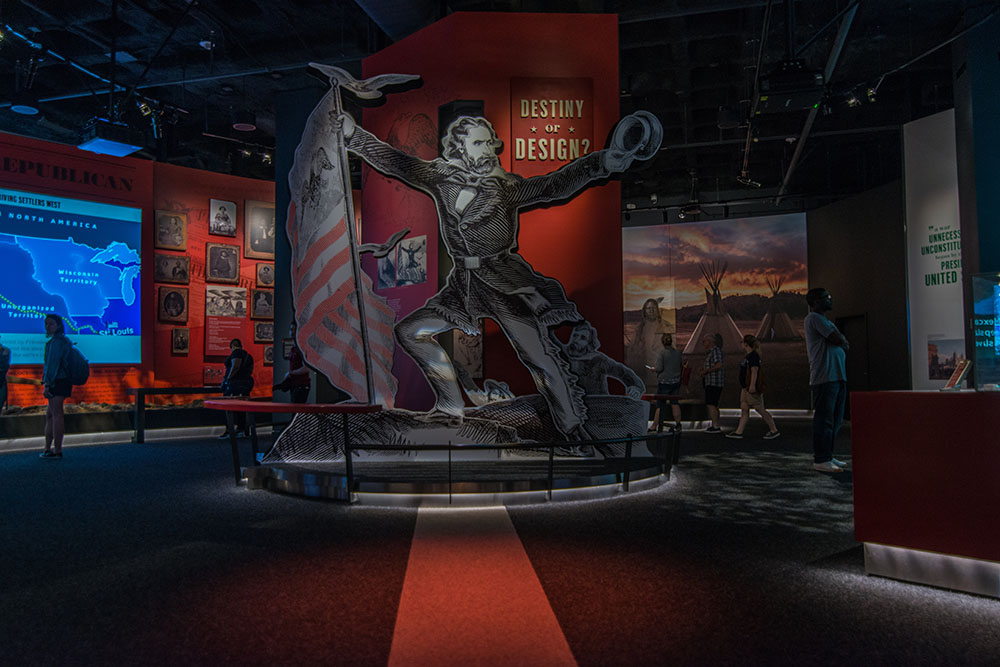
Alex and I go silent with the thunder, as if the theatrical act is supposed to end, a metaphorical curtain closing on the nicely kempt lawn, our country’s most cherished river, and a giant beautiful arch bringing embodiment to all our growing doubt. I place my hand one last time on the stainless steel before heading to bed—I want to believe in the benevolence of this place but catch a faint reflection of myself in the structure. Distorted, muted, mercurial. A representation of something undiscernible. A reflection of something familiar yet skewed, the future of our national parks.
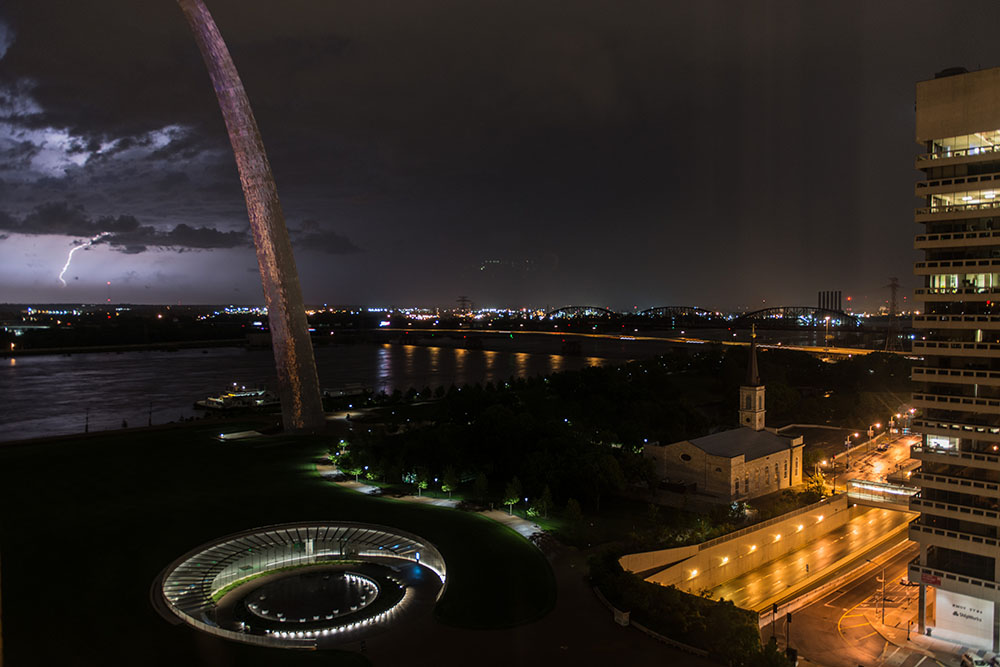
The next morning, after hotel Starbucks, we join our media tour and descend into the belly of the beast. The entrance line to the underground attractions is long, but, escorted by the park’s superintendent, Mike Ward, we bypass the wait and head straight to security. This doesn’t give much time to inspect nuance, but even from the lobby, with a stunning view of the Old Courthouse to the west, I already know it’s the nicest American museum I’ve ever seen. Everything is state-of-the-art, from the ticket center flat screen TVs to the trash cans; everything mostly beige and silver, feeling futuristic, like the deck of a Star Trek spaceship. Even the slatted ceiling creates an optical ease that makes you want to move further underground. But first: metal detectors. This gives the air of an official government building, a compound, like we’re being let in on a secret. What surprises me, amidst the extravagance, is that admission is free to the public—no cost to join this esoteric club. The equity is impressive. Even more so, ADA consideration is topnotch, thanks in part to a collaboration with Universal Design. There’s space for wheelchairs to fully approach exhibits and tactile additions for those with low visibility, bringing a heightened sensory experience for all.
After security, you cross over one of the country’s largest terrazzo maps, a U.S. atlas cast onto the floor, allowing visitors to walk historic trials of the West and follow the rivers that made St. Louis an influential nexus. Our group stops here for an introduction. Gathered are writers from various magazines and online journals, the park’s upper management—directors and presidents—plus a person from Union Pacific, public relations representatives, and two employees from the National Park Foundation.
“I could tell you stories for weeks about this place,” the Senior Director of Marketing and Partnerships tells us. “But I only have a few minutes. I’ll start with this: we couldn’t be more proud of this place and how, about ten years ago, public and private funders came together in the hopes of reconnecting the Arch with the city it represents. One of the major changes you may have already noticed is that there is only one entrance to the museum—the west entrance—from which you just came. You used to be able to enter through the Arch’s legs, but now these are just exits. What this does is streamline the experience. In order to take the tram up the Arch, which is why many people come here, you have to walk through the entire museum. The hope is that this hooks people enough to engage with the exhibits and the 201-year-old history they represent. Why don’t we head down to the main floor and take a look for ourselves.”
The first experience is called “Heading West” and it feels like home. Ten-foot-tall flat screens, resting on the floor, enlivened by rear projectors, bring to life video of prairie and bison. Passing through, you feel almost outside, though still feeling on a spaceship. It’s disorienting but fun; a clever way to welcome audiences more accustomed to technology. Beyond this, the ambiance darkens and you enter the museum proper. Despite the floorplan being a rigid “T” shape, the exhibit layout still adheres to curves. Everything pulls your attention one direction or another—this is not your typical museum. There are video presentations and animations, dioramas, art, interactive tools, panoramic images that bend around walls, artifacts, replicas of antiquated transportation and homes, didactics and placards with information that would, in fact, take weeks to learn about.
The museum is already packed and teeming with school groups, the result of brilliant programs like “Every Kid Outdoors,” the federal public lands youth initiative to get all 4th graders and their families into parks for free, and “Ticket to Ride,” which helps mitigate the common access barrier of transportation—both programs bolstered by the National Park Foundation’s fundraising. Looking back to the terrazzo map, I count three school groups heading our way, perhaps fifty kids in total, many experiencing a “national park” for the first times in their lives.
I want Gateway Arch to be this. Deeply. Madly. I want all people to have access to the privilege of parks; I want people without adequate transportation to know life beyond limited city blocks, and to know the freedom of countryside, and to know that scrambling on rocks can be just as compelling as screens and social media and video games.
I could bask in the touristry all day, indulging the entertainment, but time is precious. I dip into 1797 colonial St. Louis, mill about, but my eyes are on the executives. They’re free of engagement. It may be my only chance to make face.
“Did I hear right that it’s free to get in here?” I ask the man who addressed our group earlier.
“That’s right, the museum’s free to everyone. You just gotta go through security.”
“Okay, so what about going up the Arch? That’s not free is it?”
“No, that’s around twenty for an adult, fifteen for a kid.”
“And does a park pass then wave that fee?” I ask, curious about the eighty-dollar “America the Beautiful” annual pass that gets you onto most federal property without paying the entrance fee.
“That’s where it gets a little tricky—the NPS doesn’t actually administer the Arch, that’s a concession company called Gateway Arch, that’s who I work for. The park pass will get you three dollars off the tram ticket.” He then hands me his business card, as do the other people in his cohort. He’s right, it’s tricky: one card reads Gateway Arch; another, Jefferson National Parks Association; another, Gateway Arch Park Foundation. None from the actual National Park Service, not until Mike Ward, the superintendent meanders over, having overheard me mention that I’ve visited nearly all the U.S. national parks.
“You been to Voyageurs?” he asks.
“Yeah, couple of years ago. I love it up there.”
“Me too. I was superintendent there before taking this role.”
“You from the area.”
“From here. St. Louis.”
“How was the transition back? Pretty big change with this place becoming a full national park.”
“It’s been seamless. The whole process happened quickly. There was so much support from the community.”
“So you think it was a good move on the National Park Service’s part?”
“Rebranding this place was a necessity. People traveling through St. Louis weren’t associating the Jefferson Memorial with the Arch. They’d drive by and look, but wouldn’t stop. And many locals, too, have been here once in their lives, maybe as kids, but this is an invitation for them to return—to say, Hey, this is a place you can keep coming back to.” And that, again, seems to be the crux of the designation change: not for resource management, but better branding.
“Has there been any pushback, publicity wise, about the change,” I ask, expecting him to mention other doubters like myself.
“No, everything’s been pretty positive, except for one journalist who thought our interpretation of Manifest Destiny diminished the American accomplishment of western expansion. I had to answer a few calls about it, but not too much trouble.” This is what’s confused me from the onset of Gateway getting re-designated—no one really knows or cares. Even well-informed friends of mine in the outdoor industry haven’t heard about the change. “You say you’ve been to almost all of the parks,” Mike continues, “now are you talking the full 421 units?”
“No, just the 62 actual national parks.” I say actual with maybe too hard of an emphasis.
“You know, Jon Jarvis, the former NPS director, was trying to get rid of all the different designations. He was trying to make everything simply a ‘national park.’ Obviously didn’t get it passed, but I think—”
Someone interrupts, our tour leader. It’s time for the group to tram to the top of the Arch. No further Q & A with Mike. We both show disappointment, caught up in the conversation of a shared love. I like him. I like everyone I’ve met thus far. Because there are no villains in this story, no blatant malicious agendas on an individual level, making me then wonder if I’m the rotten one for approaching so skeptically. Because I don’t want to dislike this place. It’s just that, over the last ten years, I’ve invested a large portion of my life and ego into the parks and become such an advocate for the restorative attributes they offer. I’ve never felt a deeper silence than in the depths of Mammoth Caves or a more resolute darkness. Never felt more alone than in the backwoods of Rocky Mountain. Death Valley taught me expanse. Sequoia, size. Saguaro, repetition. There are feral horses at Mesa Verde. Fruit bats feeding on bananas in the National Park of American Samoa. Endemic Mazama newts in the crystal-clear water of Crater Lake. Places to retreat, to preserve, and to hopefully protect—
I want Gateway Arch to be this. Deeply. Madly. I want all people to have access to the privilege of parks; I want people without adequate transportation to know life beyond limited city blocks, and to know the freedom of countryside, and to know that scrambling on rocks can be just as compelling as screens and social media and video games. I’m just apprehensive to this solution, wondering if labeling an urban center as a national park can still give people the same benefits of true nature. Or if this is the equivalent of offering the malnourished fast food and calling it feeding the hungry. Maybe “true nature” is the fallacy then, a constructed idea no longer applicable to 21st century living.
My greatest hope is that this place truly becomes a gateway. That first-time park goers will enliven to the experience and resolve to make time outside a deeper intention in their day-to-day. That this park unit can be their first one and then act as an opening to their second and third, perhaps visiting Ulysses S. Grant National Historic Site or Ozark National Scenic Riverways or, further yet, Smoky Mountains National Park. I pray it spark an addiction to harder tonic.
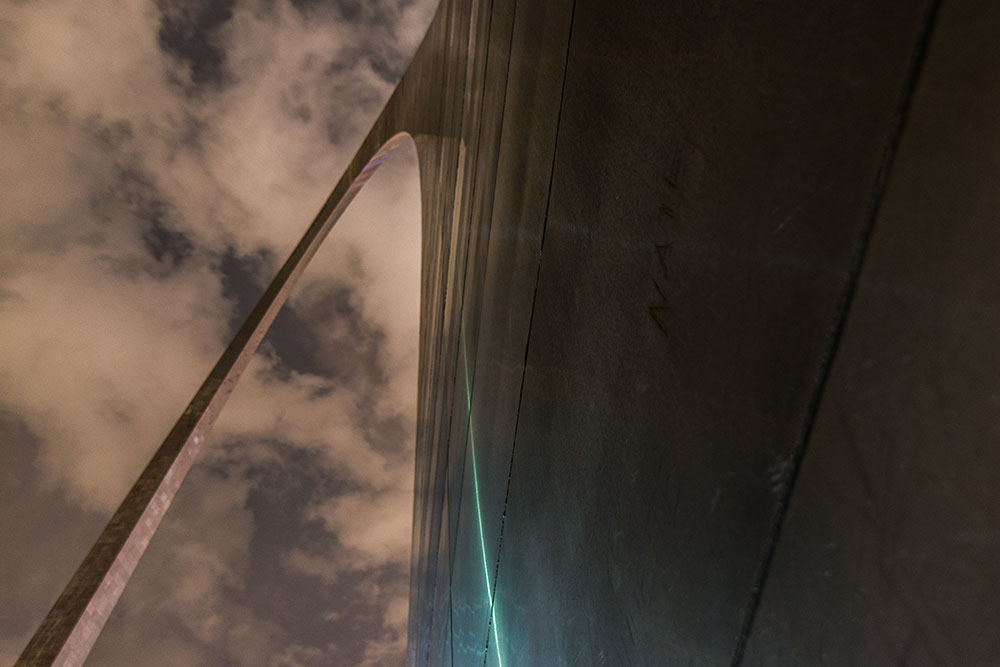
The journey to the top is perhaps the most impressive. It feels like a Disneyland ride: you wait in line, but while you do, you’re distracted by a well-edited and well-animated short film about the era of the Arch’s development. It’s projected onto distressed concrete for a hip appeal.
The next step is getting on the tram. You wait on staggered steps for the pods to come back. They drop the descenders off, and then you get on. There are five seats in these futuristic orbs, each five feet in diameter, meaning they comfortably seat about three. It takes four minutes to go up, with the pod moving by the combined mechanics of an elevator, an escalator, and a Ferris Wheel. You wouldn’t know it while riding, but the pods rotate a total of 155 degrees during ascent.
The observation deck at the top isn’t much better in terms of personal space, with a capacity of 160, but the views—my God—they are worth any discomfort. From 630 feet up, through airplane-like windows, the breadth of St. Louis is before you: interstates, a beer-sponsored baseball stadium, skyscrapers, the Mississippi, a casino, the haze of the horizon. And then there is the Old Courthouse: Greek revival style with a teal cast-iron dome and green space spreading before it. The little building from up here holds tremendous presence, especially considering it altered the trajectory of our country with the Dred and Harriet Scott case. It’s a stark reminder of how influential St. Louis was and, perhaps, still is.
From up here I can see it all: a 91-acre park, embodying the gravity of a 19th century ethos, celebrating the 200-year history of a colonial city, recognizing Manifest Destiny and its consequences, and preserving a courthouse that helped tip the scales of justice. The views are pleasantly interrupted by eager school kids rushing from window to window to see the varying panoramas. On the other side of the bridge I spot a representative from the National Park Foundation wearing an inclusive T-shirt reading “Encuentra Tu Parque.” And I can’t help but reflect on how beautiful this trip has been. How amazing. Because I know this place deserves recognition and celebration. It’s doing so many things right. But I can’t help but think of it as a microcosm for the current state of our country: an elegant parabola drawn skyward and trying to strike the perfect balance of a tumultuous past, divided present, and uncertain future. I only hope we are still on the rising side of the arc that proceeds any civilization’s fall—that reflection will be our means to progress and not collapse.
Back at the west-facing windows, I count four American flags from where I stand, the most prominent on the top of the Hyatt hotel. Jefferson was right when he proclaimed that the United States held great and many natural wonders. For the time being, when I pledge allegiance, it’s to them, our national parks.
